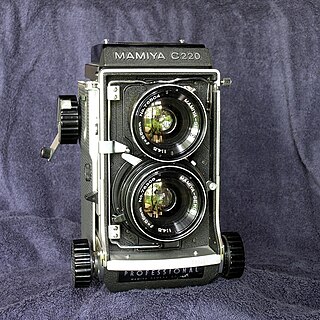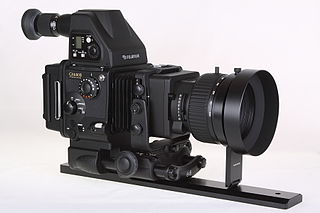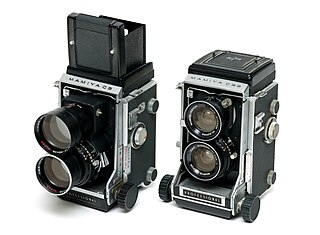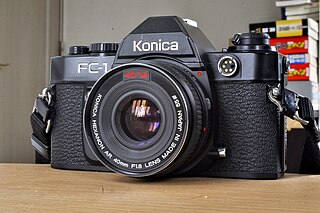Cameras
Rangefinders
Alfred Simmon received a design patent in 1953 for the "Simmon Camera". [1] The Simmon Brothers, better known at the time for their line of enlargers, built the original Simmon Omega cameras in the United States starting from 1954. These rangefinder cameras used 120 roll film, capturing images with the 6×7 "ideal format" frame size. The Omega 120 camera was equipped with a fixed Omicron 90 mm f/3.5 lens designed by Wollensak with four elements; it was designed to facilitate rapid operation as a press camera, using a large focusing knob and combined push/pull film transport lever that also served to cock the leaf shutter for the right hand and a shutter release for the left hand. [2] A flashbulb accessory was available which had a rotary turret accepting six bulbs. Keeping with the rapid operation theme, the turret was mechanically linked to the film transport lever, automatically advancing a fresh bulb to the reflector as the film was advanced. [3]

Simmon Brothers was merged into Berkey Photo in 1961. [4] Shortly thereafter, the design was licensed to Konica, another company marketed in the United States by Berkey, and manufactured in modified form as the Koni-Omega line [5] between 1964 and 1975, which included the Koni-Omega Rapid (introduced in 1964 and sold in Japan as the Konica Press) and Rapid M (1968). [4] Both cameras accepted the same set of Hexanon-branded interchangeable lenses, including the standard ( Tessar -type) 90 mm f/3.5, wide-angle ( Super-Angulon -type) 60 mm f/5.6, and telephoto ( Sonnar -type) 180 mm f/4.5. [6] The 60 mm lens was replaced by a reformulated 58 mm lens and a 135 mm portrait lens was added around 1970. [7]
The bulkier Rapid M was designed to accept interchangeable film magazines with a dark slide, permitting mid-roll changes and off-camera loading, while the Rapid was fitted with a detachable back. Because the Rapid did not have a dark slide, it was fitted with a safety blind to allow lens changes without fogging the film; both cameras had provisions to lock out the lens release lever if the dark slide or safety blind was not engaged. The magazine back for the Rapid M had two parts: a conventional film transport and rollfilm holder, and a front cover that included a slot for the dark slide. [6]
The last models, branded as Rapid Omega and bearing an all-black finish, were produced by Mamiya in the same factory, including the Rapid Omega 100 and 200 (both introduced in 1975), [4] which were similar to the Rapid and Rapid M, respectively. Production ceased in 1981. [4] This line shared the same interchangeable lenses with the preceding Koni-Omega line, although they were rebranded as Super Omegon rather than Hexanon. The magazine back introduced with the Rapid M was used for both the 100 and 200, but on the 100, the front portion of the magazine was permanently fixed to the body, so it was unable to accommodate mid-roll changes. [8]
A close-up adapter was popular with wedding photographers for portraits. The line also was sold to the United States Army, which designated it "Still Picture Camera, Type KE-58". [4]
Lenses are fitted with a leaf shutter that supports M- (flashbulb) and X- (electronic flash) synchronization via a PC terminal, up to the minimum shutter speed of 1⁄500 second.
| Focal length | Aperture | Construction | Min. focus | Angle of view | Filter | Notes | |
|---|---|---|---|---|---|---|---|
| Ele. | Grp. | ||||||
| 58 mm | f/5.6–32 | 8 | 4 | 42 in (1.1 m) | 75.4° | Series VIII | Symmetric design similar to improved Super-Angulon |
| 60 mm | f/5.6–32 | 6 | 4 | 42 in (1.1 m) | 73.5° | Series VIII | Symmetric design similar to original Super-Angulon |
| 90 mm | f/3.5–32 | 4 | 3 | 39+1⁄2 in (1.00 m) | 52.9° | Series VI | Design similar to Tessar |
| 135 mm | f/3.5–32 | 6 | 5 | 90 in (2.3 m) | 36.7° | Series VII | Design similar to Sonnar |
| 180 mm | f/4.5–32 | 5 | 4 | 12 ft (3.7 m) | 28° | Series VII | Design similar to Sonnar |
Twin-lens reflex
Konica extended its market with another line, the Koni-Omegaflex M in 1968, which was a twin-lens reflex camera that also took 6×7 rectangular pictures on 120 roll film. [4]
The two-piece Omegaflex film magazine is identical to the magazine used by the Rapid M and 200; the rear (film transport) piece can be interchanged with the 100 (also sold as the Konica Press 2 in Japan). The front piece integrates a dark slide and permits mid-roll changes on the Omegaflex, Rapid M, and 200. The earlier Koni-Omega Rapid (Konica Press in Japan) film back is not compatible with the Koni/Rapid Omega film magazine system, and does not permit mid-roll changes.
Although the lenses for the Omegaflex shared the same design as their counterparts for the Koni-Omega, the Hexanon lenses for Omegaflex were packaged as a twin-lens unit and were not interchangeable with those from the Omega line. Likewise, most other accessories were not interchangeable with those from the Omega line.
View camera
Under Berkey, view cameras were sold in the United States as the Omega View 45. [10] The cameras were built by Sakai Special Camera Mfg. Co. in Japan and marketed elsewhere as the Toyo-View; Sakai also built a field camera, which was sold as the Toyo-Field. [11] By 1985, Omega-branded view cameras were being marketed by Berkey alongside Toyo-branded view and field cameras. [12]
Distribution of the Toyo line in the United States was acquired by Mamiya America Corporation after Berkey went bankrupt; Sakai stopped manufacturing cameras in 2002, but As of 2023 [update] , the Toyo-Field 45AX camera is still available. [13]
















